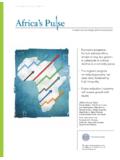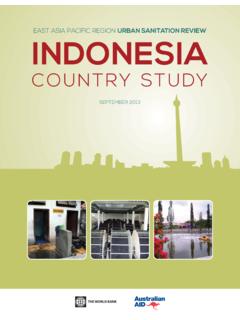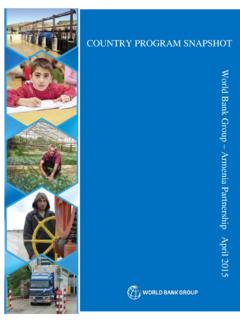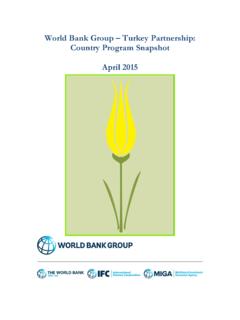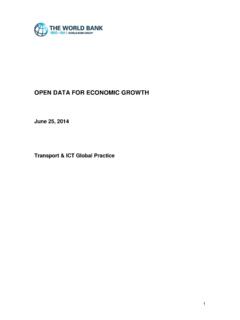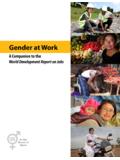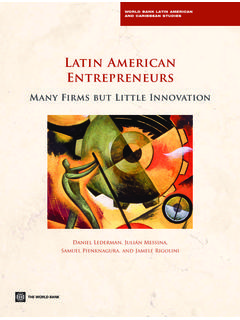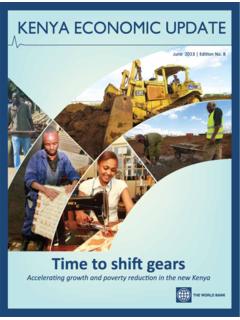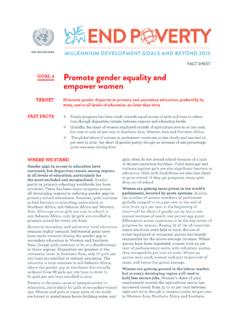Transcription of THE WORLD BANK GROUP GOALS END EXTREME …
1 THE WORLD BANK GROUP GOALS END EXTREME POVERTY ANDPROMOTE SHARED PROSPERITYCONTENTThe WORLD Bank GROUP Mission, GOALS , and Indicators 5 Ending EXTREME Poverty 10 Ending poverty within a generation difficult, but achievable 12 Promoting Shared Prosperity 18An indicator of growth with equity and inclusion 20 Shared prosperity and inequality 22 Pathways to shared prosperity and poverty reduction 25 Sustainability our planet for future generations an inclusive society ensuring fiscal sustainability 34 Figure / Box Figure 1: Regional changes in the population of EXTREME poor over the years 13 Figure 2: Poverty has fallen steadily since the 1980s except in Africa where the decline began later 14 Box 1: Destitution could continue after 2030 in some of the poorest countries 16 Figure B1: Poverty in selected low-income countries 16 Figure 3: Inequality tends to be lower in high-income countries 22 Figure 4: Shared Prosperity Indicator in selected countries (circa 2000-10) 24 Figure 5: Labor market factors contributed the most to poverty reduction, selected countries 265 THE WORLD BANK GROUP MISSION, GOALS , AND INDICATORSP hoto: Curt Carnemark6 Although poverty has declined rapidly over the past three decades, humanity still faces urgent and complex challeng-es.
2 More than 1 billion people worldwide still live in destitution, a state of affairs that is morally unacceptable given the resources and the technology available today. Moreover, rising inequality and social exclusion seem to accompany the rising prosperity in many countries. Un-der these circumstances, the WORLD Bank GROUP s overarching mission of a WORLD free of poverty is as relevant today as it has ever in the well-being of the poorer segments of society. This second goal reflects the fact that all countries aspire to rapid and sustained increases in living standards for all of their citizens, not just the already privileged. These two GOALS and their respective indicators can be summarized as:The WORLD Bank GROUP has established ambitious but achievable GOALS to an-chor its overarching mission and to galvanize international and national efforts in this endeavor.
3 Accordingly, the institution will strive to (i) end EXTREME poverty at the global level within a gen-eration and (ii) promote what may be called shared prosperity : a sustainable Photo: Arne Hoel7 End EXTREME poverty: the percentage of people living with less than $ a day to fall to no more than 3 percent globally by 2030; promote shared prosperity: foster income growth of the bottom 40 percent of the population in every EXTREME poverty within a generation and promoting shared prosperity must be achieved in such a way as to be sustainable over time and across generations. This requires promoting environmental, social, and fiscal sustainability. We need to secure the long-term future of our planet and its resources so future generations do not find themselves in a wasteland.
4 We also must aim for sustained social inclusion and limit the size of economic debt inherited by future generations. 8We are aware that these two monetary indicators do not adequately accommodate all the dimensions of poverty that represent our mission. But to insert every dimen-sion explicitly into a limited number of measures is to risk creating such complex indicators that they will be ill-understood. Each of the monetary indicators we have adopted has the advantage of capturing the key elements of welfare in a single, compelling measure. While these monetary measures will define our GOALS , we will continue to maintain a strong focus on multiple dimensions of welfare. Ending poverty and promoting shared prosperity are unequivocally also about progress in non-monetary dimensions of welfare including education, health, nutrition, and access to essential infrastructure, as well as about enhancing voice and participation of all segments of society in economic, social, and political spheres.
5 Photo: Simone D. McCourtie9 The GOALS we have articulated are not solely for the WORLD Bank GROUP to achieve but rather are GOALS that we hope are consistent with those of our 188 member countries. The GOALS will guide the WORLD Bank GROUP s strategy as we continue our transformation into a Solutions Bank by influencing what the organization does and how, and by helping it become more selective and focused in its activities. The GOALS are well-aligned with the overall objectives of the Millennium Development GOALS (MDGs) process and reiterate our unwav-ering commitment to support it and to helping shape the Post-2015 Agenda. Photo: Visual News Associates10 ENDING EXTREME POVERTY Photo: Curt Carnemark11 Ending EXTREME poverty is a moral imperative and arguably one of the most compelling challenges facing the development community.
6 We are setting a target date for reaching an EXTREME poverty rate of no more than 3 percent in 2030, using the internationally established measure of the proportion of people living on less than $ a day. While representing a very frugal threshold, the $ standard is well-accepted in the development community as one of the Millennium Development GOALS , and it would allow the WORLD Bank GROUP to focus its central mission in measurable, intui-tive, and transparent terms. Reaching the target, which would effectively end EXTREME poverty globally in less than a generation, is an ambitious endeavor. It will require sustaining high rates of economic growth across the developing WORLD , as well as translating growth more effectively into poverty reduction in each developing country.
7 Reaching the target also requires governance, institutional, and social policy changes not seen yet in many poor countries, and hence enormous efforts from national governments and the international poverty within a generation difficult, but achievable the poor, and preventing inequality from increasing. Also, a one percentage point reduction in EXTREME poverty per year becomes progressively harder to achieve as the rate declines, because each suc-cessive one percentage point represents an increasingly larger share of the overall poverty rate. One might thus expect the pace of global poverty reduction to slow down in the coming years relative to the trend in previous decades. Transforming the trajectory to maintain the histori-cal trend in effect requires bending the natural arc of ambition of the target can also be seen in other respects.
8 China accounted for more than half of the total reduc-tion in global poverty between 1980 and 2000, but China s overall contribu-tion would precipitously decline as it comes closer to ending EXTREME poverty. Recent history shows this trend starkly (Figure 1). Between 1981 and 2010, when the number of EXTREME poor in the WORLD dropped, the proportion of the poor in East Asia and Pacific (including China) fell from around 57 percent to 20 per-cent as the number of poor in the region declined dramatically. Reducing the global EXTREME poverty rate to no more than 3 percent in 2030 is not a prediction. It is a target that we consider difficult but achievable, given recent experience. It will require a fall in poverty by about one percentage point per year during this period, which is about the same as the average annual reduction seen since 1980.
9 It implies maintaining a growth rate of per capita household income in the developing WORLD at least as high as that achieved since the same time, maintaining such a growth rate will be far from business as usual. That trajectory is a highly optimis-tic scenario, as it assumes continuing the pattern of strong growth in the de-veloping WORLD , successfully managing any global shock to limit its impact on Reducing the global EXTREME poverty rate to no more than 3 percent in 2030 is not a prediction. It is a target that we consider difficult but achievable, given recent experience. 1302004006008001,0001,2001,4001,6001,800 2,0002010199919901981 East Asia and Pacific (including China)South Asia (including India)Sub-Saharan AfricaOther regionsmillionsFigure 1: Regional changes in the population of EXTREME poor over the yearsNote: Other regions are Europe and Central Asia, Middle East and North Africa, and Latin America and the Caribbean.
10 Source: WORLD Bank database, based on country household reach the global target for 2030, the pace of poverty reduction in Sub-Saharan Africa and South Asia will assume increas-ing importance. For Sub-Saharan Africa, where two decades of disappoint-ment have been followed by a decade of unprece-dented poverty reduction during the 2000s (Figure 2), a further acceleration of this trend is extent of the challenge in low-income countries, many of which are in Sub-Saharan Africa, is illustrated by the high rates of current EXTREME pov-erty. More than one-third of countries in Sub-Saharan Africa, several of them fragile and conflict-affected states, had an EXTREME poverty rate of more than 50 percent in 2010.

